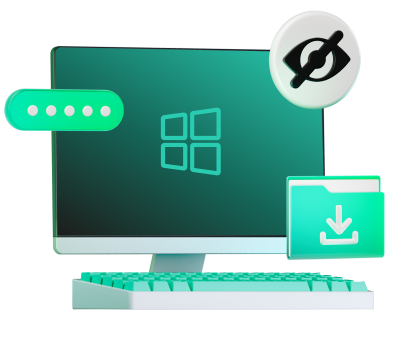How to keep your account from getting hacked
What for: So you don't get hacked.
If your password is short and simple, cybercriminals can guess it and hijack your account. A long and complex password is more secure. Use a strong password that:
- Is at least 8 characters long;
- Contains lowercase and uppercase letters, numbers, and special characters ($, @, etc.);
- Is not an actual word or easy-to-guess phrase;
- Is not the same as your passwords for any other accounts;
- Does not consist of information that strangers could easily find out (your name, date of birth, pet's name, and so forth — or those of your friends or relatives).
To change your LinkedIn password:
- Click your profile picture in the top menu and select Settings & Privacy;
- Go to Sign in & Security section and click Change password;
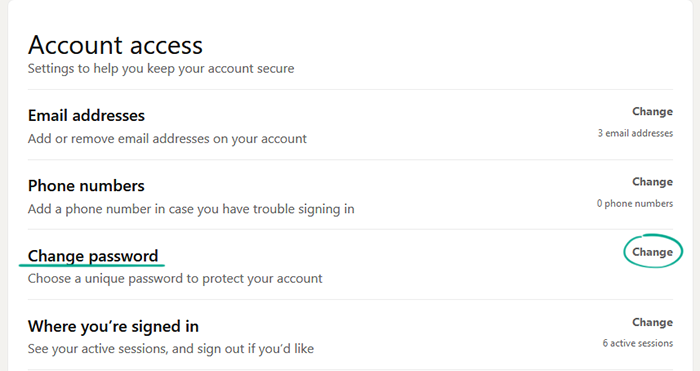
- Enter your current password;
- Enter a new strong password twice;
- Tick the Require all devices to sign in with new password check box;
- Click Save.
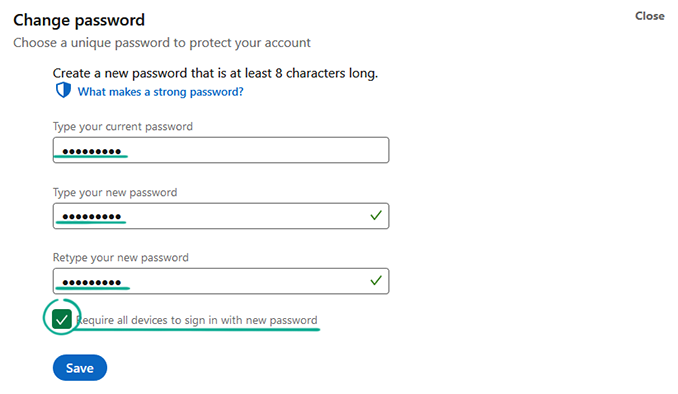
What for: So you definitely don't get hacked.
You can increase the security of your account by enabling 2-step verification. Then, every time you try to sign in to your LinkedIn account, you will have to provide a one-time code received via text message or through a special app. Even if cybercriminals get hold of your username and password, they will not be able to log in to your account without this code.
To enable two-step verification via text message:
- Click your profile picture in the top menu and select Settings & Privacy;
- Go to the Sign in & Security section and click Two-step verification;
- Click Turn on next to Two-step verification is turned off;

- In the Choose your verification method drop-down list, select Phone Number (SMS) and click Continue;
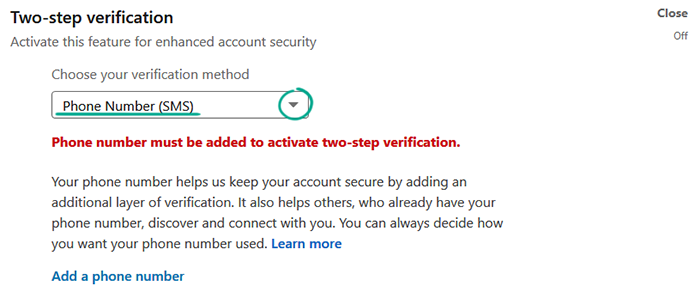
- Enter your LinkedIn account password and click Done;
- In the corresponding box on the page, enter the verification code you've received and click Verify.
To receive verification codes through an authenticator app:
- Click your profile picture in the top menu and select Settings & Privacy from the drop-down list;
- Go to the Sign in & Security section and click Two-step verification;
- Make sure that two-step verification is turned on;
- Click Change verification method, select Authenticator App in the drop-down list, and click Continue;
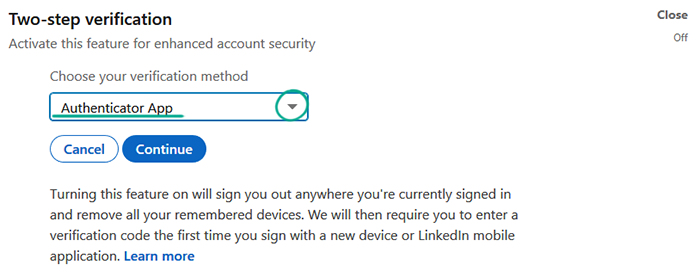
- Enter your LinkedIn account password and click Done;
- Add your LinkedIn account to the app by using the QR code or the secret key provided on the screen;
- Get your verification code in the app and enter it under Enter the 6-digit code generated by your Authenticator app;
- Click Continue.
What for: So you don't get hacked.
If your password is short and simple, cybercriminals can guess it and hijack your account. A long and complex password is more secure. Use a strong password that:
- Is at least 8 characters long;
- Contains lowercase and uppercase letters, numbers, and special characters ($, @, etc.);
- Is not an actual word or easy-to-guess phrase;
- Is not the same as your passwords for any other accounts;
- Does not consist of information that strangers could easily find out (your name, date of birth, pet's name, and so forth — or those of your friends or relatives).
To change your LinkedIn password:
- Click your profile picture in the top menu and select Settings & Privacy;
- Go to Sign in & Security section and click Change password;
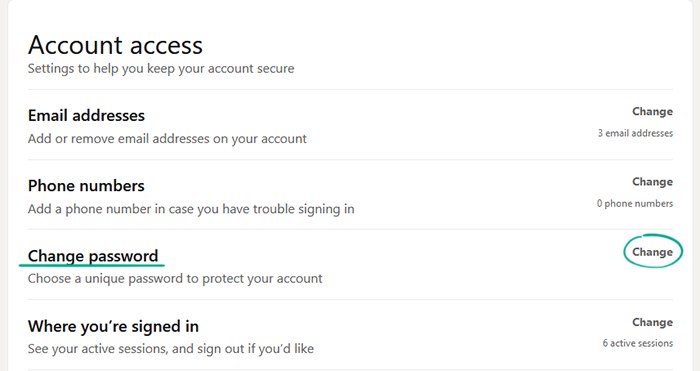
- Enter your current password;
- Enter a new strong password twice;
- Tick the Require all devices to sign in with new password check box;
- Click Save.
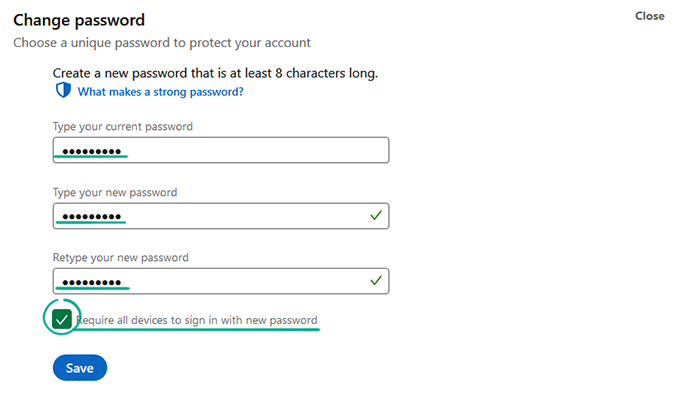
What for: So you definitely don't get hacked.
You can increase the security of your account by enabling 2-step verification. Then, every time you try to sign in to your LinkedIn account, you will have to provide a one-time code received via text message or through a special app. Even if cybercriminals get hold of your username and password, they will not be able to log in to your account without this code.
To enable two-step verification via text message:
- Click your profile picture in the top menu and select Settings & Privacy;
- Go to the Sign in & Security section and click Two-step verification;
- Click Turn on next to Two-step verification is turned off;

- In the Choose your verification method drop-down list, select Phone Number (SMS) and click Continue;
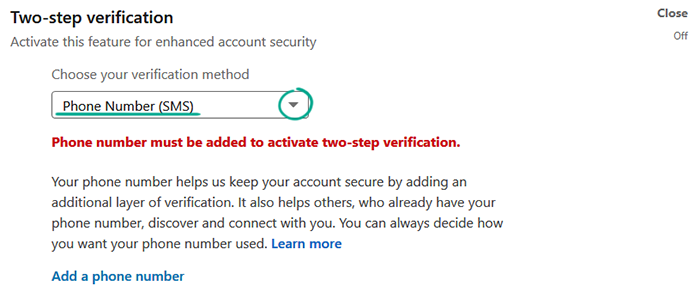
- Enter your LinkedIn account password and click Done;
- In the corresponding box on the page, enter the verification code you've received and click Verify.
To receive verification codes through an authenticator app:
- Click your profile picture in the top menu and select Settings & Privacy from the drop-down list;
- Go to the Sign in & Security section and click Two-step verification;
- Make sure that two-step verification is turned on;
- Click Change verification method, select Authenticator App in the drop-down list, and click Continue;
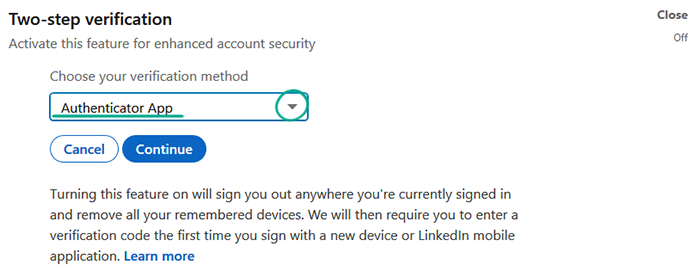
- Enter your LinkedIn account password and click Done;
- Add your LinkedIn account to the app by using the QR code or the secret key provided on the screen;
- Get your verification code in the app and enter it under Enter the 6-digit code generated by your Authenticator app;
- Click Continue.
How to hide your data from prying eyes
What for: To keep strangers from knowing too much about you.
By default, your LinkedIn profile data is visible to all users, even if they do not have an account. In addition, information from your profile is indexed by search engines and ends up in their search results. If you want to restrict access to this data, make your profile private:
- Click your profile picture in the top menu and select Settings & Privacy;
- Go to the Visibility section;
- Under Visibility of your profile & network, click Edit your public profile;
- Turn off the toggle for Your profile's public visibility in the lower right corner of the screen.
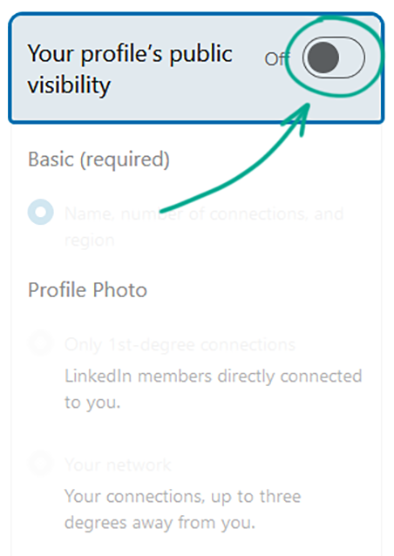
To configure which of your account data will be public, do the following under Edit Visibility:
- Select who may view your Profile Photo:
- Only 1st-degree connections;
- Your network;
- All LinkedIn members.
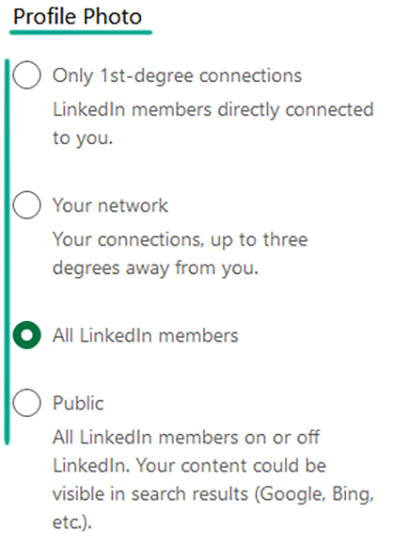
- Limit the visibility of the Headline, Current Experience, Past Experience, Details and other fields (such as information on education) to keep them from being seen by all users.

To configure the visibility of your connections:
- Click your profile picture in the top menu and select Settings & Privacy;
- Go to the Visibility section;
- Under Visibility of your profile & network, select the following:
- Who can see or download your email address;
- Connections;
- Who can see your last name.

- To stop search engines from accessing your profile data, click Profile discovery and visibility off LinkedIn and turn off this option.
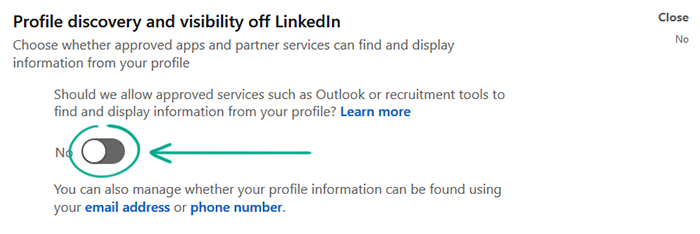
What for: To keep strangers from learning who and what you are interested in.
By default, all LinkedIn users can see the photo and name of people who visited their page. If you do not want to inform profile owners that you viewed their data, hide information about your visits:
- Click your profile picture in the top menu and select Settings & Privacy;
- Go to the Visibility section;
- Under Visibility of your profile & network, select Profile viewing options;
- Select Private mode.
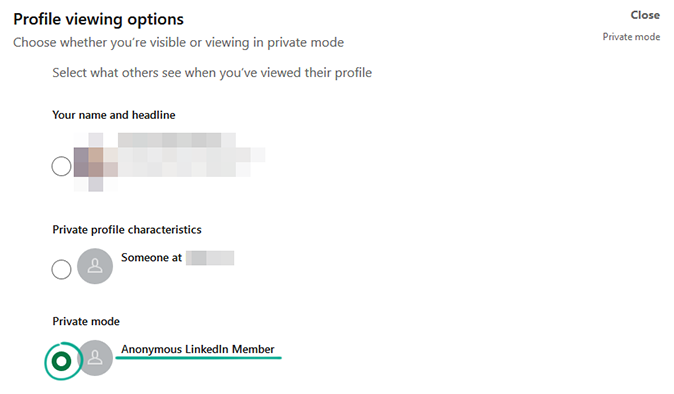
Downside: If you have a basic account, you will not be able to see who viewed your profile. If you have Premium status, you will see all visitors of your page except for those using private mode.
What for: To keep strangers from knowing too much about you.
LinkedIn users can receive notifications regarding changes to your profile data and mentions of your account in other members' news or posts. If you do not want strangers to keep tabs on your life, turn off this feature:
- Click your profile picture in the top menu and select Settings & Privacy;
- Go to the Visibility section;
- Under Visibility of your LinkedIn activity, turn off the following options:
- Share profile updates with your network;
- Notify connections when you're in the news;
- Mentions or Tags.

If you want to delete a mention of you from another user's post:
- Open the post from which you want to remove the mention;
- Click the three dots button in the upper right corner of the window;
- Select Remove mention;
- Click Remove.
What for: To not get spied on.
By default, all LinkedIn users can follow you and receive notifications about your activity. To keep anyone who is not one of your connections from following you:
- Click your profile picture in the top menu and select Settings & Privacy;
- Go to the Visibility section;
- Under Visibility of your LinkedIn activity, select Followers;
- Select Your connections.

What for: To keep unwanted people from finding your profile.
People can use the phone number and e-mail address specified in your LinkedIn profile to find your account. This is convenient, but not always safe. For example, fraudsters can gather your personal information this way.
To keep people from finding your profile by your phone number or e-mail address:
- Click your profile picture in the top menu and select Settings & Privacy;
- Go to the Visibility section;
- Under Visibility of your profile & network, click Profile discovery using email address and select Nobody;
- Click Profile discovery using phone number and select Nobody.

Downside: It will be harder for potential employers, partners, and colleagues to find your profile.
How to keep corporations out of your business
What for: To keep LinkedIn from knowing what you are interested in.
LinkedIn saves your search queries to personalize your searches, ads, and news feed. If you do not want your search queries to be used for personalization of social network content, keep the service from saving them:
- Click your profile picture in the top menu and select Settings & Privacy;
- Go to the Data privacy section;
- Under How LinkedIn uses your data, select Search history;
- Click Clear search history and confirm this action.

What for: To hide from LinkedIn how you respond to employers.
When you respond to a job opening, the employer may ask you to fill out an application on their website or on LinkedIn. In both cases, LinkedIn saves your answers and uses them to improve the service and enhance targeted ad selection. If you do not want to share your answers with LinkedIn, keep it from saving this information:
- Click your profile picture in the top menu and select Settings & Privacy;
- Go to the Data privacy section;
- Under Job seeking preferences, select Job application settings;
- Turn off the toggle for Save and manage your resumes and answers.

What for: To keep LinkedIn from learning too much about you.
LinkedIn can use the contact lists of other services, such as e-mail or calendar on your smartphone. Based on this data, the social network gives you suggestions on who you should follow, receives data on meetings and tasks, generates a news feed, and selects targeted ads. In addition, this information may be shared with third parties, which increases the risk of leaks.
To delete other contacts and calendar information from your profile:
- Click Connection under your profile picture;
- Go to the Contacts section;
- Select Manage synced contacts;
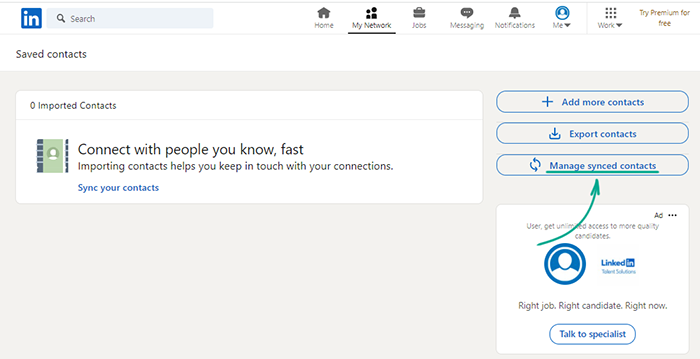
- Under Contacts and Calendar, click Stop sync then Remove all to delete the data.
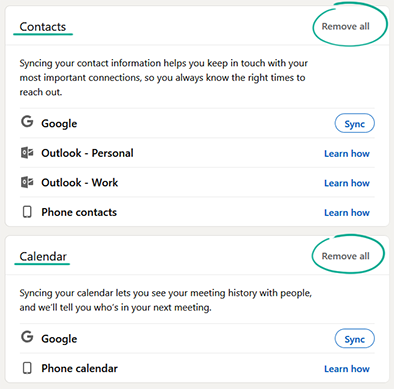
What for: So that LinkedIn does not share your information with third parties.
LinkedIn may send your profile information to analysts for research and improvement. If you do not want to share this data with strangers, stop the social network from doing this:
- Click your profile picture in the top menu and select Settings & Privacy;
- Go to the Data privacy section;
- Under How LinkedIn uses your data, select Social, economic, and workplace research;
- Turn off the toggle in this section.
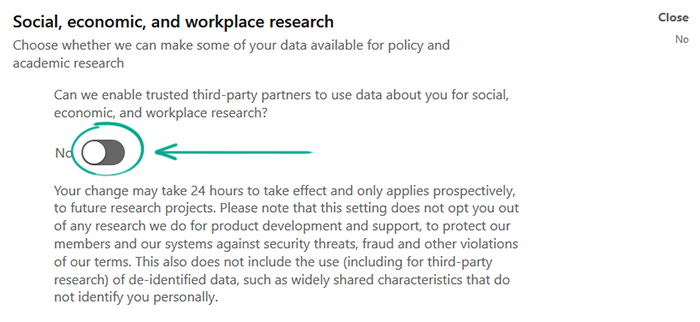
Note that LinkedIn will still transmit depersonalized information about your account to its partners, for example, for fraud prevention.
What for: To decide for yourself what information to provide.
When you respond to a job opening, the employer receives a full copy of your LinkedIn profile. If you do not want to share this information, keep the social network from sending it:
- Click your profile picture in the top menu and select Settings & Privacy;
- Go to the Data privacy section;
- Under Job seeking preferences, select Sharing your profile when you click Apply;
- Turn off the toggle in this section.

What for: To see which of your data LinkedIn saves.
To find out what information the social network collects and save it in case your account gets blocked, removed or hijacked, download a file containing all your profile data.
To download the archive:
- Click your profile picture in the top menu and select Settings & Privacy;
- Go to the Data privacy section;
- Under How LinkedIn uses your data, select Get a copy of your data;
- Tick Download larger data archive, including connections, contacts, account history, and information we infer about you based on your profile and activity;
- Click Request archive.
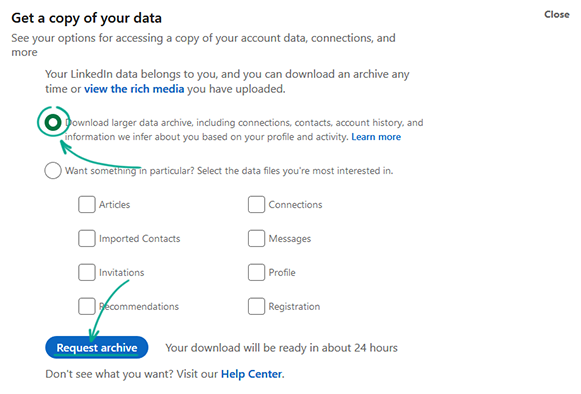
- Enter your LinkedIn account password and click Done.
Within 24 hours, you will receive an archive download link at the e-mail address linked to your account.
What for: To keep LinkedIn from personalizing ads based on your actions and interests.
LinkedIn may use various information about you and your activity on the social network for ad selection purposes. If you are annoyed by targeted ads, stop the use of your data.
To turn off ad personalization:
- Click your profile picture in the top menu and select Settings & Privacy;
- Go to the Advertising data section;
- Turn off the toggles in the following sections:
- Profile data for personalizing ads;
- Interest categories;
- Connections;
- Location;
- Demographics;
- Companies you follow;
- Groups;
- Education;
- Job information;
- Employer;
- Audience insights for websites you visit;
- Ads outside of LinkedIn;
- Interactions with businesses;
- Ad-related actions.

After doing this, you will continue to see ads, but they will not be based on your personal data.
How to configure notifications
What for: To avoid distractions.
Notifications about private messages, comments and other activity in LinkedIn may appear as pop-up messages or arrive by e-mail. Frequent notifications can be annoying, and getting a large number of them increases the chances that you will miss something important.
To disable excessive notifications:
- Click your profile picture in the top menu and select Settings & Privacy;
- Go to the Communications section;
- Under How you get your notifications, go through the On LinkedIn, Email, and Push sections and turn off the notifications you do not want to receive.
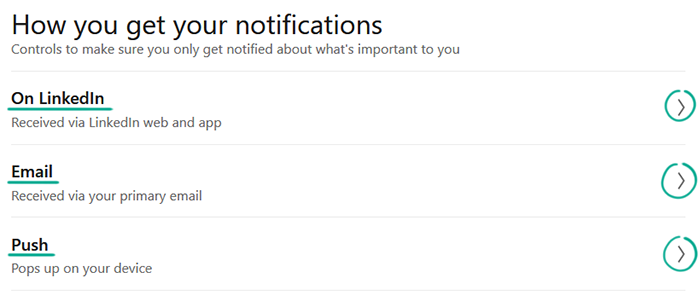
What for: To avoid distractions.
Notifications about private messages, comments and other activity in LinkedIn may appear as pop-up messages or arrive by e-mail. Frequent notifications can be annoying, and getting a large number of them increases the chances that you will miss something important.
To disable excessive notifications:
- Click your profile picture in the top menu and select Settings & Privacy;
- Go to the Communications section;
- Under How you get your notifications, go through the On LinkedIn, Email, and Push sections and turn off the notifications you do not want to receive.
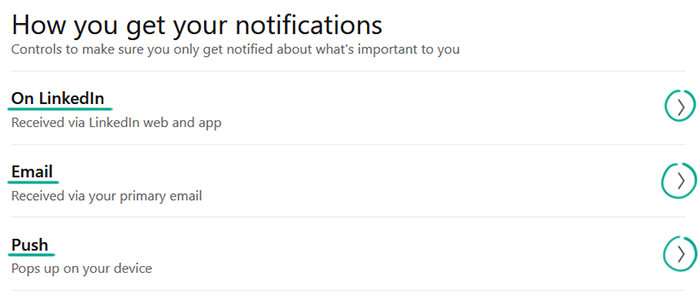
What for: To keep strangers from seeing your notifications.
Even when you're not on the LinkedIn website, you may see pop-up notifications about incoming messages, invitations, job ads, and your network connections' activities. They may also appear on your device sign-in screen. If you do not want strangers to see them in your absence, disable push notifications:
- Click your profile picture in the top menu and select Settings & Privacy;
- Go to the Communications section;
- Under How you get your notifications, go through the Push section and turn off all notifications for all categories.
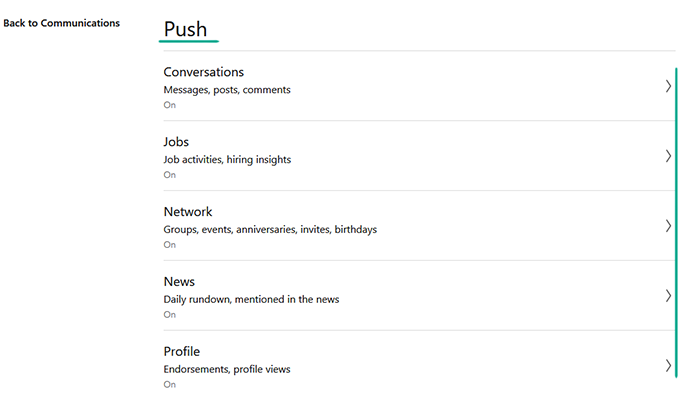
Downside: You will be able to view notifications only on the LinkedIn website.
How to feel comfortable with LinkedIn
What for: To avoid unpleasant people.
To stop a user from viewing your profile, commenting on your posts, or sending you messages, block them:
- Go to the profile of the user you wish to block;
- Click More… in the profile header;
- Select Report/Block;
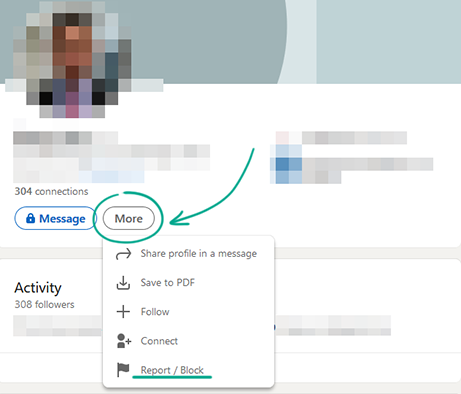
- Click Block member;
- Click Block.
The user will not know you've blocked them.
What for: To avoid unpleasant people.
To stop a user from viewing your profile, commenting on your posts, or sending you messages, block them:
- Go to the profile of the user you wish to block;
- Click More… in the profile header;
- Select Report/Block;
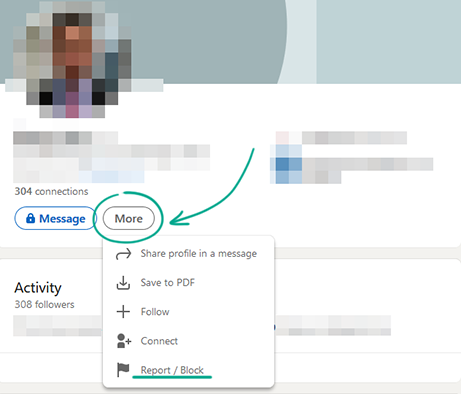
- Click Block member;
- Click Block.
The user will not know you've blocked them.
What for: To hide that you are online.
By default, all LinkedIn users can see when you are on the website or when you were last logged in. If you do not want strangers to know when you are online, make your network status visible to your contacts only or to nobody.
To configure your network status:
- Click your profile picture in the top menu and select Settings & Privacy;
- Go to the Visibility section;
- Under Visibility of your LinkedIn activity, select Manage active status;
- Select Your Connections only or No one.
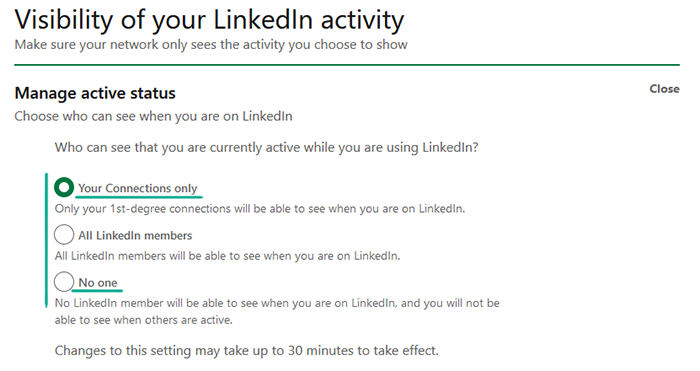
Downside: You also will not be able to see the network status of other users.

